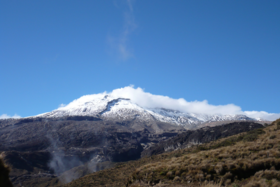Nevado del Ruiz
| Nevado del Ruiz | |
|---|---|
| La Mesa de Herveo | |

Steam on the mountain in July 2007
|
|
| Highest point | |
| Elevation | 5,321 m (17,457 ft) |
| Prominence | 2,035 m (6,677 ft) |
| Listing | Ultra |
| Coordinates | 04°53′43″N 75°19′21″W / 4.89528°N 75.32250°WCoordinates: 04°53′43″N 75°19′21″W / 4.89528°N 75.32250°W |
| Geography | |
| Location | Caldas/Tolima, Colombia |
| Parent range | Cordillera Central, Andes |
| Geology | |
| Age of rock | |
| Mountain type | Stratovolcano |
| Volcanic arc/belt | Northern Volcanic Zone, Andean Volcanic Belt |
| Last eruption | December 2014 to June 2016 (ongoing) |
| Climbing | |
| First ascent | 1936 by Cunet and Gansser |
The Nevado del Ruiz (Spanish pronunciation: [neβaðo ðel ˈrwis]), also known as La Mesa de Herveo (English: Mesa of Herveo, the name of the nearby town), or Kumanday in the language of the local pre-Colombian indigenous people, is a volcano located on the border of the departments of Caldas and Tolima in Colombia, about 129 kilometers (80 mi) west of the capital city Bogotá. It is a stratovolcano, composed of many layers of lava alternating with hardened volcanic ash and other pyroclastic rocks. Nevado del Ruiz has been active for about two million years, since the early or late Pliocene epoch, with three major eruptive periods. The current volcanic cone formed during the present eruptive period, which began 150 thousand years ago.
The volcano usually generates Plinian eruptions, which produce swift-moving currents of hot gas and rock called pyroclastic flows. These eruptions often cause massive lahars (mud and debris flows), which pose a threat to human life and the environment. The impact of such an eruption is increased as the hot gas and lava melt the mountain's snowcap, adding large quantities of water to the flow. On November 13, 1985, a small eruption produced an enormous lahar that buried and destroyed the town of Armero in Tolima, causing an estimated 25,000 deaths. This event later became known as the Armero tragedy—the deadliest lahar in recorded history. Similar but less deadly incidents occurred in 1595 and 1845, consisting of a small explosive eruption followed by a large lahar.
...
Wikipedia

